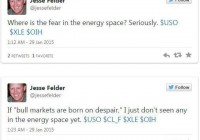Respect The Trends In These ‘Widowmaker’ Trades
“Bull-markets are born on pessimism, grow on skepticism, mature on optimism and die on euphoria.” -Sir John Templeton There are a couple of trends out there in the markets right now that are becoming so-called “widowmakers.” Specifically, I’m referring to oil and long bonds. Oil has been crashing while long bonds have been soaring. Oil is way oversold and long bonds are way overbought. They should both probably retrace a bit of their recent moves simply because they’re both so overextended right now. However… See the massive inflows into the oil ETF in the chart above? That is not the sort of “pessimism” that forms a major bottom. Conversely, in bonds… Investors have been drastically underweight and heavily short bonds for over a year now. This is why I’ve been writing for some time that bonds may be more likely than stocks to see a ” blow off ” sort of move. Now traders are clearly trying to anticipate a trend change in both of these asset classes. They are getting heavily long oil and they remain heavily short long bonds. Now, to be clear, I think they may revert a bit if only to work off their overextendedness (if that’s even a word). But the big problem with these trades is that the trend is plain as day and traders shouldn’t forget, “the trend is your friend!” Oil is nowhere close to breaking out of its downtrend and long bonds are nowhere close to breaking down out of their uptrend. Trying to anticipate these trend changes must have been inordinately painful for these traders over the past few months. And the odds are neither of these trends will actually change until we see some real despair in oil and some true euphoria in long bonds, as witnessed in ETF flows or some other similar indicator. At least, that’s what I imagine the brilliant Sir John would have told us. How did this change your view of ? More Bullish More Bearish It Didn’t This impact ( ) More Bullish More Bearish Unchanged Thanks for sharing your thoughts. Submit & View Results Skip to results » Share this article with a colleague
